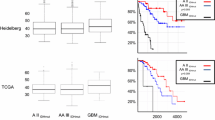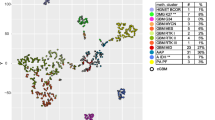Abstract
IDH wild type (IDHwt) anaplastic astrocytomas WHO grade III (AA III) are associated with poor outcome. To address the possibilities of molecular subsets among astrocytoma or of diagnostic reclassification, we analyzed a series of 160 adult IDHwt tumors comprising 120 AA III and 40 diffuse astrocytomas WHO grade II (A II) for molecular hallmark alterations and established methylation and copy number profiles. Based on molecular profiles and hallmark alterations the tumors could be grouped into four major sets. 124/160 (78 %) tumors were diagnosed as the molecular equivalent of conventional glioblastoma (GBM), and 15/160 (9 %) as GBM-H3F3A mutated (GBM-H3). 13/160 (8 %) exhibited a distinct methylation profile that was most similar to GBM-H3-K27, however, lacked the H3F3A mutation. This group was enriched for tumors of infratentorial and midline localization and showed a trend towards a more favorable prognosis. All but one of the 120 IDHwt AA III could be assigned to these three groups. 7 tumors recruited from the 40 A II, comprised a variety of molecular signatures and all but one were reclassified into distinct WHO entities of lower grades. Interestingly, TERT mutations were exclusively restricted to the molecular GBM (78 %) and associated with poor clinical outcome. However, the GBM-H3 group lacking TERT mutations appeared to fare even worse. Our data demonstrate that most of the tumors diagnosed as IDHwt astrocytomas can be allocated to other tumor entities on a molecular basis. The diagnosis of IDHwt diffuse astrocytoma or anaplastic astrocytoma should be used with caution.






Similar content being viewed by others
References
Balss J, Meyer J, Mueller W, Korshunov A, Hartmann C, von Deimling A (2008) Analysis of the IDH1 codon 132 mutation in brain tumors. Acta Neuropathol 116:597–602
Cancer Genome Atlas Research Network (2015) Comprehensive, integrative genomic analysis of diffuse lower-grade gliomas. N Engl J Med. doi:10.1056/NEJMoa1402121
Capper D, Weißert S, Balss J et al (2010) Characterization of R132H mutation specific IDH1 Antibody binding in brain tumors. Brain Pathol 20:245–254
Hartmann C, Hentschel B, Wick W et al (2010) Patients with IDH1 wild type anaplastic astrocytomas exhibit worse prognosis than IDH1 mutated glioblastomas and IDH1 mutation status accounts for the unfavorable prognostic effect of higher age: implications for classification of gliomas. Acta Neuropathol 120:707–718
Hartmann C, Meyer J, Balss J et al (2009) Type and frequency of IDH1 and IDH2 mutations are related to astrocytic and oligodendroglial differentiation and age: a study of 1010 diffuse gliomas. Acta Neuropathol 118:469–474
Horbinski C (2013) What do we know about IDH1/2 mutations so far, and how do we use it? Acta Neuropathol 125:621–636
Ichimura K, Pearson DM, Kocialkowski S, Backlund LM, Chan R, Jones DT, Collins VP (2009) IDH1 mutations are present in the majority of common adult gliomas but are rare in primary glioblastomas. Neuro Oncol 11:341–347
Killela PJ, Reitman ZJ, Jiao Y et al (2013) TERT promoter mutations occur frequently in gliomas and a subset of tumors derived from cells with low rates of self-renewal. Proc Natl Acad Sci 110:6021–6026
Koelsche C, Sahm F, Capper D et al (2013) Distribution of TERT promoter mutations in pediatric and adult tumors of the nervous system. Acta Neuropathol 126:907–915
Koelsche C, Wöhrer A, Jeibmann A, Schittenhelm J, Schindler G, Preusser M, Lasitschka F, von Deimling A, Capper D (2013) Mutant BRAF V600E protein in ganglioglioma is predominantly expressed by neuronal tumor cells. Acta Neuropathol 125:891–900
Labussiere M, Idbaih A, Wang XW et al (2010) All the 1p19q codeleted gliomas are mutated on IDH1 or IDH2. Neurology 74:1886–1890
Louis D, Ohgaki H, Wiestler O, Cavenee W (2007) World Health Organization classification of tumours of the central nervous system. In: Bosman F, Jaffe E, Lakhani S, Ohgaki H (eds) World Health Organization Classification of Tumours, 4th edn. IARC, Lyon
Louis DN, Perry A, Burger P et al (2014) International Society of Neuropathology—Haarlem consensus guidelines for nervous system tumor classification and grading. Brain Pathol 24:429–435. doi:10.1111/bpa.12171
Noushmehr H, Weisenberger DJ, Diefes K et al (2010) Identification of a CpG island methylator phenotype that defines a distinct subgroup of glioma. Cancer Cell 17:510–522
Olar A, Wani KM, Alfaro-Munoz KD et al (2015) IDH mutation status and role of WHO grade and mitotic index in overall survival in grade II-III diffuse gliomas. Acta Neuropathol 129:585–596
Parsons DW, Jones S, Zhang X et al (2008) An integrated genomic analysis of human glioblastoma multiforme. Science 321:1807–1812
Prabowo AS, van Thuijl HF, Scheinin I et al (2015) Landscape of chromosomal copy number aberrations in gangliogliomas and dysembryoplastic neuroepithelial tumours. Neuropathol Appl Neurobiol. doi:10.1111/nan.12235
Reuss DE, Mamatjan Y, Schrimpf D et al (2015) IDH mutant diffuse and anaplastic astrocytomas have similar age at presentation and little difference in survival: a grading problem for WHO. Acta Neuropathol 129:867–873
Reuss DE, Sahm F, Schrimpf D et al (2015) ATRX and IDH1-R132H immunohistochemistry with subsequent copy number analysis and IDH sequencing as a basis for an “integrated” diagnostic approach for adult astrocytoma, oligodendroglioma and glioblastoma. Acta Neuropathol 129:133–146
Schwartzentruber J, Korshunov A, Liu X et al (2012) Driver mutations in histone H3.3 and chromatin remodelling genes in pediatric glioblastoma. Nature 482:226–231
Sturm D, Witt H, Hovestadt V et al (2012) Hotspot mutations in H3F3A and IDH1 define distinct epigenetic and biological subgroups of glioblastoma. Cancer Cell 22:425–437
Suzuki H, Aoki K, Chiba K et al (2015) Mutational landscape and clonal architecture in grade II and III gliomas. Nat Genet 47:458–468. doi:10.1038/ng.3273
Turcan S, Rohle D, Goenka A et al (2012) IDH1 mutation is sufficient to establish the glioma hypermethylator phenotype. Nature 483:479–483
Venneti S, Santi M, Felicella MM et al (2014) A sensitive and specific histopathologic prognostic marker for H3F3A K27M mutant pediatric glioblastomas. Acta Neuropathol 128:743–753
Watanabe T, Nobusawa S, Kleihues P, Ohgaki H (2009) IDH1 mutations are early events in the development of astrocytomas and oligodendrogliomas. Am J Pathol 174:653–656
Weller M, Weber RG, Willscher E et al (2015) Molecular classification of diffuse cerebral WHO grade II/III gliomas using genome- and transcriptome-wide profiling improves stratification of prognostically distinct patient groups. Acta Neuropathol 129:679–693
Wiestler B, Capper D, Sill M et al (2014) Integrated DNA methylation and copy-number profiling identify three clinically and biologically relevant groups of anaplastic glioma. Acta Neuropathol 128:561–571
Yan H, Parsons DW, Jin G et al (2009) IDH1 and IDH2 mutations in gliomas. N Engl J Med 360:765–773
Yip S, Butterfield YS, Morozova O et al (2012) Concurrent CIC mutations, IDH mutations, and 1p/19q loss distinguish oligodendrogliomas from other cancers. J Pathol 226:7–16
Acknowledgments
Part of this work was undertaken at UCLH/UCL which received funding from NIHR. We thank Maria Fernanda Ruiz, Kerstin Lindenberg, Viktoria Zeller for technical assistance. FS is a fellow of the Medical Faculty Heidelberg Physician-Scientist Program. Supported by the Bundesministerium für Bildung und Forschung (BMBF) program SYS-GLIO and the German Cancer Net (DKTK) joint funding project “Next generation molecular diagnostics of malignant gliomas”.
Author information
Authors and Affiliations
Corresponding author
Electronic supplementary material
Below is the link to the electronic supplementary material.
401_2015_1454_MOESM5_ESM.xlsx
Supplementary material 5 (XLSX 26 kb) Supplementary Table 2: Molecular alterations in 160 patients with IDHwt astrocytoma
Rights and permissions
About this article
Cite this article
Reuss, D.E., Kratz, A., Sahm, F. et al. Adult IDH wild type astrocytomas biologically and clinically resolve into other tumor entities. Acta Neuropathol 130, 407–417 (2015). https://doi.org/10.1007/s00401-015-1454-8
Received:
Revised:
Accepted:
Published:
Issue Date:
DOI: https://doi.org/10.1007/s00401-015-1454-8




